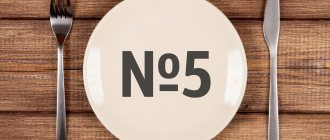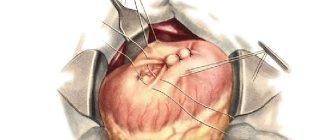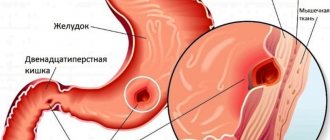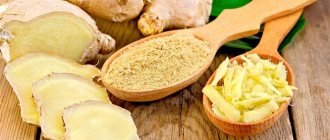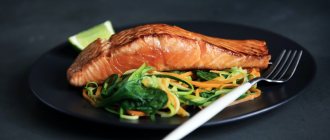What's on the menu?
As part of diet No. 1, soups based on vegetable broth with the addition of vermicelli, rice, and various vegetables are welcomed. You can also season soups with cream or boiled egg. Fish and lean meats are allowed.
You should avoid rye bread, but you can replace it with dried bread or crackers. The diet also involves a complete rejection of puff pastry, fatty meats and canned food, salty cheeses, hot sauces and marinades. White cabbage, mushrooms, sorrel, spinach, onions, cucumbers, carbonated drinks, black coffee are contraindicated.
List of permitted products:
— Soups can be prepared from permitted pureed vegetables in carrot or potato broth. Milk soups made from pureed or well-cooked cereals (rolled oats, semolina, rice) with the addition of vermicelli and pureed vegetables and pureed soup from pre-cooked chicken or meat are allowed.
Article on the topic
In search of gastritis. What tests will help identify the disease? Meat and fish broths, mushroom and strong vegetable broths, cabbage soup, borscht, and okroshka are completely excluded.
— Bread and flour products are prohibited, but not completely. It is allowed to eat wheat bread made from premium and 1st grade flour, but only yesterday’s baked bread or dried bread. Sweet flour products include dry sponge cake, dry biscuits, well-baked savory buns, baked pies (with apples, boiled meat or fish and eggs, jam) and cheesecakes with cottage cheese.
Rye and any fresh bread, products made from butter and puff pastry are completely excluded.
— Meat and poultry can only be lean, without tendons and skin. Steamed and boiled dishes from beef, young lean lamb and trimmed pork, chicken, and turkey are allowed. Lean veal, chicken and rabbit can be eaten, but only boiled. Steamed cutlets, meatballs, quenelles, souffles, mashed potatoes, zrazy and beef stroganoff made from boiled meat are also allowed.
Fatty or stringy varieties of meat and poultry, canned food and smoked products are completely excluded.
- Fish - you can use low-fat types without skin, in pieces or in the form of cutlets. Fish can be boiled or steamed.
Fatty and salty types of fish, as well as canned fish, are completely excluded.
— Dairy products are allowed, in particular, you can drink milk, cream, non-acidic kefir, yogurt. Fresh non-acidic cottage cheese and sour cream (but in small quantities), baked cheesecakes, soufflé, lazy dumplings, puddings, and mild grated cheese are also allowed.
Dairy products with high acidity, sharp, salty cheeses are completely excluded.
— Eggs can be cooked soft-boiled or in the form of an omelet, 2-3 pieces per day.
Hard-boiled and fried eggs are completely excluded.
- Cereals - semolina, rice, buckwheat, oatmeal are allowed. Porridges are cooked in milk or water, semi-viscous and pureed. You can also prepare cutlets from ground cereals, boil vermicelli and finely chopped boiled pasta.
Millet, pearl barley, barley and corn cereals, all legumes and whole pasta are completely excluded.
Article on the topic
Stomach ulcer: how does it develop and what does it mean?
— Vegetables should be steamed or served pureed.
You can use potatoes, carrots, beets, cauliflower, and rarely green peas. You can use early pumpkin and zucchini in a non-grated form. Finely chopped dill can be added to soups. Tomatoes - only ripe, non-acidic and a maximum of 100 g. White cabbage, turnips, rutabaga, radishes, sorrel, spinach, onions, cucumbers, salted, pickled and pickled vegetables, mushrooms, canned vegetable snacks are completely excluded.
— Snacks are acceptable, but only boiled tongue, liver pate, doctor’s sausage, milk sausage, diet sausage, jellied fish in vegetable broth, sturgeon caviar, soaked low-fat herring and mincemeat, mild cheese, unsalted ham without fat.
All spicy and salty snacks, canned food, and smoked foods are completely excluded.
- Sweets . You can eat boiled and baked berries and fruits, purees, jelly, mousses, jellies, compotes, always pureed. You can also use butter cream, milk jelly, sugar, honey, non-sour jam, marshmallows and marshmallows.
Sour, insufficiently ripe, fiber-rich fruits and berries, unprocessed dried fruits, chocolate and ice cream are completely excluded.
— Sauces and spices . Moderate consumption of sour cream, fruit and milk-fruit sauces is allowed. Dill, parsley, vanillin, and cinnamon are allowed very limitedly.
Article on the topic
And what is useful is harmful? How can healthy foods be dangerous? Meat, fish, mushroom, tomato sauces, horseradish, mustard and pepper are completely excluded.
- Beverages . Weak tea, tea with milk, cream, weak cocoa and coffee with milk are allowed. Sweet juices from fruits and berries, as well as rosehip decoction.
Carbonated drinks, kvass, and black coffee are completely excluded.
— Fats and oils . You can - unsalted butter, premium quality cow's ghee, refined vegetable oils added to dishes.
All other fats are completely excluded.
Table No. 3
Recommendations for product types
Indications:
- chronic diseases and functional bowel disorders accompanied by constipation.
Diet: 4–5 times a day
Duration of appointment: unlimited
Nutrition Features:
Food is prepared mostly unchopped, boiled in water or steamed, or baked. Vegetables and fruits are consumed raw or boiled. The diet includes cold first and sweet dishes and drinks.
Modifications: 1A and 1B
Diet table No. 1 has two modifications: No. 1A and 1B. For table No. 1A, all dishes are prepared in liquid and porridge form or in the form of mashed puree. It is recommended to eat 6-7 times a day, while vegetables in any form, as well as fruits and bread are strictly prohibited. Such a strict diet is prescribed in the first two weeks of exacerbation of a peptic ulcer, acute or chronic gastritis, as well as a week after gastric surgery.
Table 1B differs from table 1A in the ratio of proteins, fats and carbohydrates and calorie content. Dishes are also prepared in liquid or porridge form, and you need to eat 5-6 times; vegetables, fruits and bread are prohibited. Table No. 1B is prescribed after completion of the course of treatment using table No. 1A.
Table No. 0
Recommendations for product types
Indications:
- undergone surgical interventions on the gastrointestinal tract
- rehabilitation of patients in the intensive care unit
- cerebrovascular accident
- after traumatic brain injury
- for patients with infectious diseases who are in serious condition.
Diet: 5–8 times a day
Duration of appointment: as needed
Nutritional features: this diet is designed to restore the patient’s vitality, replenish nutrients and increase the overall resistance of the body. The diet is very strict.
Recipes
Below are recipes for which you need to know some rules. When steaming, the product should not come into contact with liquid, but should be cooked in boiling steam. The loss of nutrients is less than during cooking and poaching. Omelettes, puddings and egg porridge are cooked in a water bath.
First meal
Oat milk soup
Oatmeal, milk, water, egg, sugar, butter.
Place oatmeal in water and cook until tender. Rub, add salt and sugar, season with the egg-milk mixture, gradually adding it to the porridge. Heat in a water bath until thickened. Serve with a piece of butter.
Puree rice soup with meat
Boil the meat and beat in a blender. Rinse the rice and cook until fully cooked, rub through a sieve. Add boiled meat to the pureed soup, add and bring to a boil. Serve with a pat of butter.
Second courses
Steamed cod soufflé
Boil the fish fillet and blend in a blender. Prepare a white sauce from flour and milk, mix it with minced meat, add salt, add yolk, butter and stir. Carefully fold the beaten egg whites into the minced meat, place everything in a greased pan and steam.
Egg porridge
Ingredients: 2 eggs, 60 ml milk, salt, 2 tsp. oils
The eggs are diluted with milk and beaten, salt and butter are added, the mixture is poured into a bowl, which is placed in a pan of water. Cook while stirring until the consistency of porridge. It can be prepared in another way: the egg mass is poured into a pan with warm water (in a small amount) and cooked like regular porridge until thickened. The remaining water is decanted.
Dessert
Curd soufflé with condensed milk
Rub the cottage cheese, add the yolk, sugar, milk, flour. Beat the whites and finally add them to the curd mixture. Place it in a mold and steam it. Serve with condensed milk.
Indications for use
The treatment menu is recommended by a doctor for the following diseases:
- gastritis;
- ulcer;
- enteritis;
- irritable bowel syndrome;
- burn of the esophagus;
- diaphragmatic hernia;
- dumping syndrome;
- GERD;
- after operations associated with gastrointestinal diseases.
Dietary table No. 1 b is prescribed for various gastrointestinal diseases.
Fully or partially limited products
- Excluded from the diet: any types of bread, bakery and confectionery products.
- Any broths.
- Fried foods.
- Fatty fish and meats, as well as rough meats with connective tissue (bird skin, fish and cartilage).
- There is a complete exclusion of vegetables and fruits in any form except jelly and jellies.
- You should not consume fermented milk drinks, cheese, regular cottage cheese, or sour cream.
- Mushrooms (as a difficult-to-digest product), smoked meats and various snacks.
- Coffee, strong tea, cocoa, carbonated drinks, vegetable juices and undiluted fruit juices are prohibited.
- Sauces (vinegar, ketchup, mayonnaise) and spices are prohibited.
Table of prohibited products
| Proteins, g | Fats, g | Carbohydrates, g | Calories, kcal | |
Vegetables and greens | ||||
| vegetables | 2,5 | 0,3 | 7,0 | 35 |
| horseradish | 3,2 | 0,4 | 10,5 | 56 |
Cereals and porridges | ||||
| corn grits | 8,3 | 1,2 | 75,0 | 337 |
| pearl barley | 9,3 | 1,1 | 73,7 | 320 |
| millet cereal | 11,5 | 3,3 | 69,3 | 348 |
| barley grits | 10,4 | 1,3 | 66,3 | 324 |
Bakery products | ||||
| white bread crackers | 11,2 | 1,4 | 72,2 | 331 |
| rye crackers | 16,0 | 1,0 | 70,0 | 336 |
| wheat bread | 8,1 | 1,0 | 48,8 | 242 |
| Rye bread | 6,6 | 1,2 | 34,2 | 165 |
Confectionery | ||||
| jam | 0,3 | 0,2 | 63,0 | 263 |
| candies | 4,3 | 19,8 | 67,5 | 453 |
Ice cream | ||||
| ice cream | 3,7 | 6,9 | 22,1 | 189 |
Raw materials and seasonings | ||||
| mustard | 5,7 | 6,4 | 22,0 | 162 |
| ketchup | 1,8 | 1,0 | 22,2 | 93 |
| mayonnaise | 2,4 | 67,0 | 3,9 | 627 |
| ground black pepper | 10,4 | 3,3 | 38,7 | 251 |
| chilli | 2,0 | 0,2 | 9,5 | 40 |
Dairy | ||||
| kefir | 3,4 | 2,0 | 4,7 | 51 |
| sour cream | 2,8 | 20,0 | 3,2 | 206 |
| curdled milk | 2,9 | 2,5 | 4,1 | 53 |
Meat products | ||||
| pork | 16,0 | 21,6 | 0,0 | 259 |
Sausages | ||||
| dry-cured sausage | 24,1 | 38,3 | 1,0 | 455 |
| sausages | 12,3 | 25,3 | 0,0 | 277 |
Bird | ||||
| smoked chicken | 27,5 | 8,2 | 0,0 | 184 |
| duck | 16,5 | 61,2 | 0,0 | 346 |
| smoked duck | 19,0 | 28,4 | 0,0 | 337 |
| goose | 16,1 | 33,3 | 0,0 | 364 |
Fish and seafood | ||||
| dried fish | 17,5 | 4,6 | 0,0 | 139 |
| smoked fish | 26,8 | 9,9 | 0,0 | 196 |
| canned fish | 17,5 | 2,0 | 0,0 | 88 |
Oils and fats | ||||
| creamy margarine | 0,5 | 82,0 | 0,0 | 745 |
| animal fat | 0,0 | 99,7 | 0,0 | 897 |
| cooking fat | 0,0 | 99,7 | 0,0 | 897 |
Non-alcoholic drinks | ||||
| black tea | 20,0 | 5,1 | 6,9 | 152 |
| * data is per 100 g of product | ||||
Table No. 7
Recommendations for product types
Indications:
- acute nephritis in the recovery phase;
- chronic nephritis without exacerbation;
- nephropathy of pregnant women and other diseases requiring a salt-free diet.
Diet: 4–5 times a day
Duration of appointment: long
Nutritional features: the diet is complete, practically no different from the diet of a healthy person. Patients are advised not to abuse protein foods (up to 0.8–0.9 g/kg) and somewhat limit salt (7–8 g/day).
Table No. 7a
Indications:
- acute and chronic nephritis in the acute stage;
- terminal chronic renal failure.
Diet: 5 times a day
Appointment period: several days
Nutritional features: modification of the basic diet with the complete exclusion of salt, severe restriction of fluid and protein.
Table No. 7b
Indications:
- recovery period after acute kidney inflammation;
- CRF.
Diet: 5 times a day
Duration of appointment: from several days to several months
Nutritional features: modification of the basic diet with restriction of salt and protein, is transitional from No. 7a to No. 7
Tables No. 7v and No. 7d
Prescribed to persons with severe nephrotic syndrome and those on hemodialysis, respectively.
They represent a modification of the basic diet with increased protein content.
Table No. 11
Recommendations for product types
Indications:
- tuberculosis of the lungs, bones, lymph nodes, joints with a mild exacerbation or its attenuation, with low body weight;
- exhaustion after infectious diseases, surgery, injuries.
Diet: 4–5 times a day
Duration of appointment: 1–2 months or more
Nutrition Features:
The diet has a high energy value with a high content of proteins, minerals and vitamins.
Table No. 9
Recommendations for product types
Indications:
- mild to moderate diabetes mellitus;
- establishing tolerance to carbohydrates;
- selection of doses of insulin or other drugs.
Diet: 5 times a day
Duration of appointment: sometimes for life
Dietary features: dishes are served boiled, baked, steamed, fried - to a limited extent.


